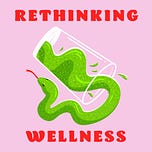
Happy unofficial first day of summer! Our spring sale is still going through the end of the month: from now through May 31, get 20% off for 1 year when you sign up for a new annual subscription to Rethinking Wellness. You’ll get access to this full essay and all of our other subscriber-only content, including critical deep dives into nutrition and wellness trends, juicy extended podcast interviews, and more.
*This essay discusses pregnancy, fertility, and body-image issues.
For the better part of a year, I’ve been going through fertility treatments to try to get pregnant with a second child.1
I naively thought the hard part was over after my husband and I conceived our first kid through IVF: we had more embryos frozen, so this time around I didn’t have to go through the grueling process of “egg retrieval”—where they pump you full of injectable hormones to get your body to produce multiple eggs at once, then remove those eggs one at a time with a long needle. Having already survived that painful first step, now I just had to prepare my body to help an embryo implant.
I was lucky that for me, that preparation involved only one shot plus a couple non-injectable hormonal medications. The actual “embryo transfer,” when doctors place the tiny collection of cells into the uterus, was as quick and relatively painless as a routine exam at the OB/GYN.
The hard part came next: waiting to find out if it had worked. That in-between state, the limbo of it all, took a huge toll on me—physically as well as emotionally.
Whoever said “you can’t be a little bit pregnant” never went through IVF.
Of course, the embryo ultimately either implants in the uterus or it doesn’t. (For me it didn’t, even after three separate embryo transfers, but I’m in the process of trying once more.)2 Still, being flooded with estrogen and progesterone from the meds, and the ensuing physical changes—including the extreme bloating that meant I had to start wearing maternity clothes right away—can sure make a person feel pregnant.
Couple those shifts in body size and shape with a surge in moodiness, sensitivity, and nausea from the hormones, plus the anxiety of having to wait a couple weeks to find out whether you’re actually pregnant or just getting tricked by your body, and it can become incredibly difficult to feel comfortable in your own skin. Speaking of skin: mine’s been constantly breaking out, and the other day I accidentally scratched off a new mole-type thing on my neck that I’d never seen before. For anyone in this situation, body-image distress is practically inevitable.
I feel fortunate that when I did the first step of IVF five years ago, I was already in solid, long-term eating-disorder recovery and had done a lot of work to disentangle from diet culture—I’d even written a book about it. Also, prior to these latest rounds of IVF, I’d already been through one pregnancy and postpartum recovery that tested and strengthened my ability to accept my body no matter what. I was in a good place, and STILL I’ve felt rattled by the recent ups and downs.
For a while I had a hard time finding anything to wear in my closet, which was bursting at the seams with clothes that just didn’t work for me. I could count on one hand the times I’d truly felt good in my clothes since my daughter was born. Even the maternity stuff I’d liked the last time around wasn’t quite right. A lot of it emphasized the belly in a way that now felt like a privilege reserved for people who were more than “a little bit pregnant” and ready to broadcast it to the world.
Then, after the second failed embryo transfer, I started to feel compelled to exercise even when I didn’t really want to or have the time, because I started worrying that the reason none of my embryos were sticking had to do with not moving my body enough. This was based not on anything my doctor said or any scientific research I read, but just on internalized diet/wellness-culture beliefs and a desire to find something to blame. I know that if my weight were higher, that pressure would probably have been even more intense—and it would likely have come from doctors and other outside sources as well, not just from my own mind.
In the grand scheme of things, I’m lucky these tough body-image moments haven’t been worse, and for the most part they’ve come and gone—but it’s taken intentional effort and ongoing conversations with supportive people to shift out of the unhelpful thought patterns. I thought I’d share some of what’s helped me in this process, in case you find it useful, too.
Here are 5 things I’m trying to keep in mind as I navigate a changing body—especially as we enter this most skin-baring of seasons, when pressure from diet and wellness culture can feel particularly intense.











